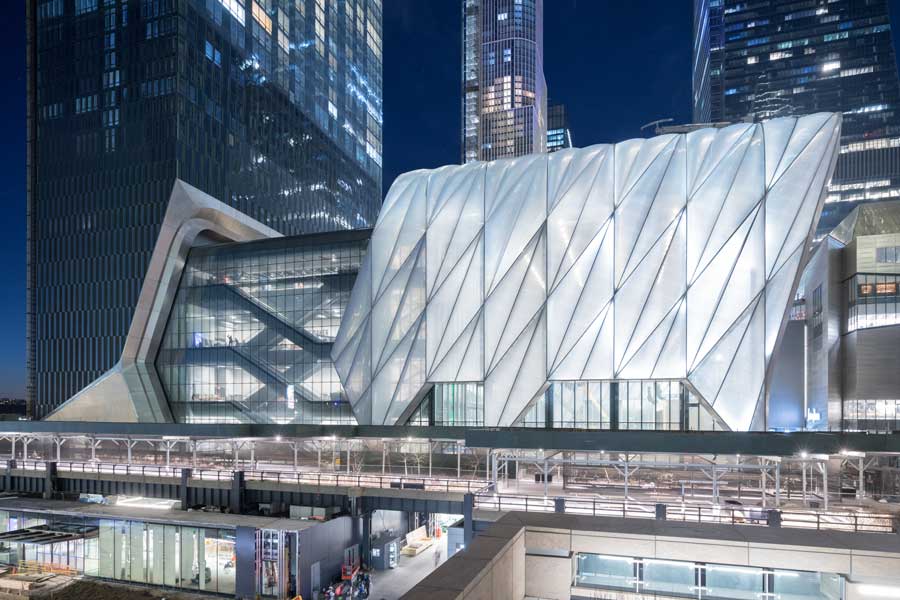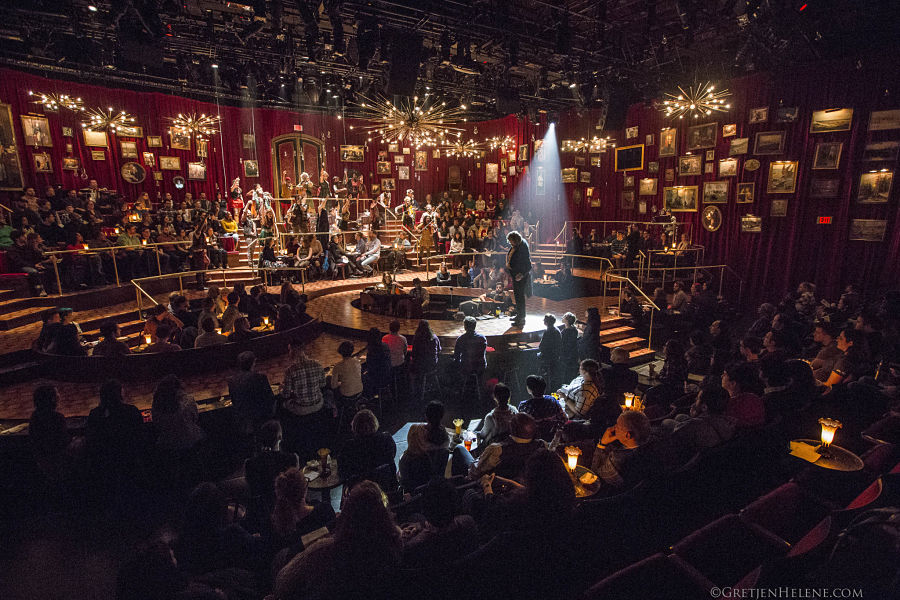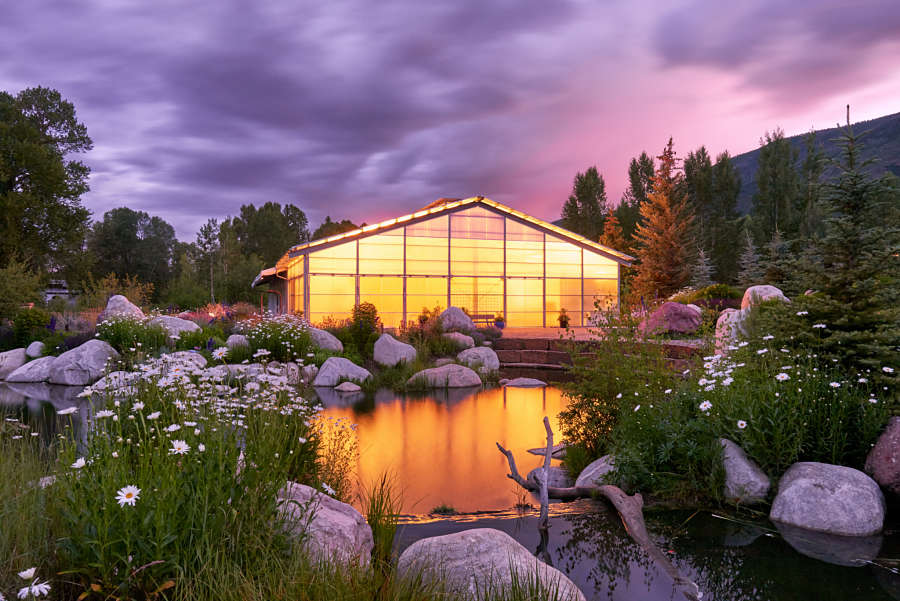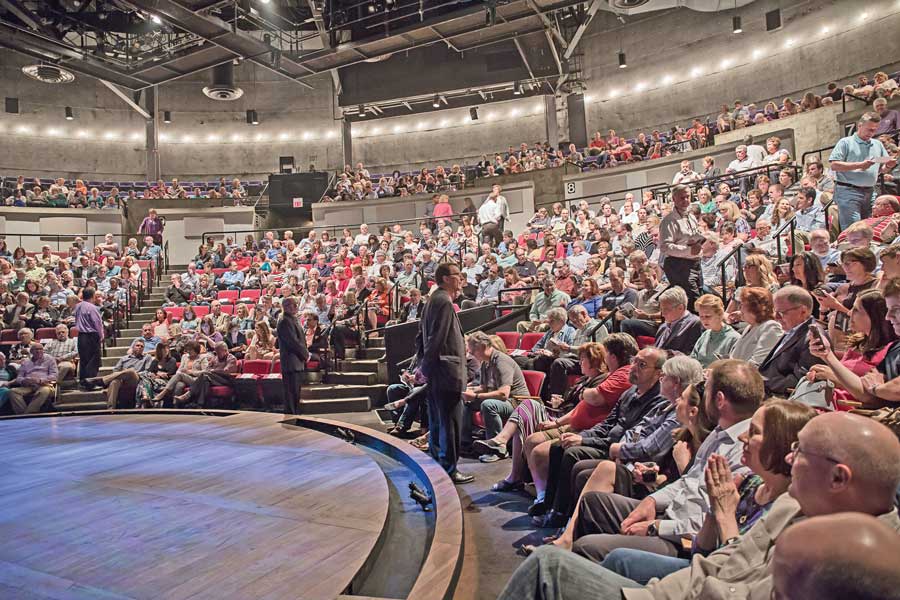In English the word theatre refers both to the art form and to the place in which it is being presented. Both meanings, and the connection between the two, are currently being radically redefined. And that redefinition is reflected in the buildings themselves.
“I do not even know what state-of-the-art means anymore,” confesses Joshua Dachs, a principal of the New York-based theatre design firm Fisher Dachs Associates, currently involved in projects under construction around the world.
The most high-profile changes at the moment are in Manhattan. How, in a city that already has 1,200 cultural institutions, can a new one stand out? That’s the question Michael Bloomberg posed when he was mayor of New York City. Fourteen years later, a Brit named Alex Poots is running a $475 million response to the question, situated on Manhattan’s far West Side. The Shed comprises five spaces for shows and exhibitions, with its two main spaces being the Griffin, which can seat 500, and the McCourt, a cavernous theatre 120 feet high offering up to 1,200 seats for theatrical spectacles and 2,000 standing for rock concerts.The latter space can also disappear entirely, as a movable outer shell retracts onto the building to create an outdoor plaza for “large-scale, site-specific” works.
Critics have given mixed reviews to the Shed’s work so far, from a performance piece in the Griffin, Norma Jeane Baker of Troy, featuring Ben Whishaw and Renée Fleming, to the “kung fu musical” Dragon Spring Phoenix Rise in the McCourt. The disapproval has extended beyond the shows onstage. In his New York Times review of Dragon Spring, Jesse Green wrote that “the Shed…supported with $75.5 million in public funds, needs to set higher goals than those of a high-end mall.”
For all the rough reception of its inaugural efforts, the Shed already stands out from the rest of the $25 billion real estate development of which it is a part, Hudson Yards, a concentration of overly tall, over-priced glass buildings that has been widely panned as what Green’s colleague, Times architect critic Michael Kimmelman, decried for its glorification of “surface spectacle.” By contrast, at the official opening of the Shed in the spring, Elizabeth Diller, one of its architects, spoke of the arts center as something of a mission, calling the building “an anti-institutional institution” and a facility “perpetually unfinished” that aims to cater to artists and audiences of the future.
“I think what’s new about the Shed is that its spaces are adaptable—that’s what encouraged me to take this job,” Poots says in its lobby. Poots was hired in 2014 to be the artistic director and CEO, after a career that included 10 years as founding artistic director of the Manchester International Festival and three years as artistic director of New York City’s Park Avenue Armory. “It can adapt to a lot of different types of performing arts, a lot of different types of visual arts, and a lot of different types of pop culture.”
Once hired, Poots convinced the board to change the name from the Culture Shed to make it sound more egalitarian, and to embrace a mission of nurturing both emerging and established artists by premiering “original works of art, across all disciplines, for all audiences.” Indeed the Shed also has two galleries for exhibitions, and a skylit multipurpose room for rehearsals, artist development, and sui generis events on the top of the eight-story building.
The Shed is located at the southernmost border of Hudson Yards, on West 30th Street, near the previously desolated 11th Avenue, and at the head of the High Line, an old elevated railroad converted into a public park. Further downtown are two major arts centers slated to open in New York City, both of which also plan to present theatre regularly as part of a multidisciplinary mission. Despite all the cultural competition, they arguably stand out just as much as the Shed.
The Ronald O. Perelman Performing Arts Center has been, in a sense, almost two decades in the making. It is under construction at the site of the World Trade Center; plans for some kind of arts center began not long after Sept. 11, 2001. Named after the billionaire investor and philanthropist whose $75 million donation in 2016 got the long-delayed project back on track, the Perelman Center is aiming for a completion date within a year after the 20th anniversary of 9/11. The center is being led by Bill Rauch, whose career up to this point has been entirely in theatre, as the founding artistic director of Cornerstone Theater for 20 years, followed by his much-lauded stint at the helm of the Oregon Shakespeare Festival since June 2007.
At his new job, which he assumed over the summer, he will be overseeing not just theatre but dance, contemporary chamber opera, music, and film (the Perelman is a possible venue for the Tribeca Film Festival). These will all be presented in three flexible venues which can combine into 11 different possible configurations, ranging from 84 to 1205 seats.
“The Perelman houses are very intimate, and there’s a lot of flexibility,” Rauch says. “I imagine that theatre will be one of the most present art forms in the Perelman. I have no doubt that projects and artists sharing this building will inevitably influence one another. I find that possibility, I’d even say that inevitability, completely energizing.”
What most distinguishes this performing arts center, though, is its location.
“There’s no way you can start up on that sacred ground, and not have it inform every choice,” Rauch avers. “That doesn’t mean it will be relentless 9/11 art. The whole notion is a response to 9/11. It’s about building community and building hope, and bringing people together. It’s about creating work that contributes to the discourse as a society. It’s about expanding what we mean by world trade. That’s the point. And that’s certainly what attracted me to the job.”
Finally, Pier55 is the brainchild of billionaire Barry Diller and his wife Diane von Furstenberg, who are footing the $250 million bill for a futuristic 2.4-acre public park built on pilings over the Hudson River near the Meatpacking District. Aiming for a spring 2021 completion, the park promises to feature “three unique performance spaces,” including a 700-seat waterfront amphitheatre, offering music, dance, and theatre. Playwright George C. Wolfe, director Stephen Daldry, and producer Scott Rudin have signed on to help develop productions for the space.
These three venues are only the most visible among the new arts buildings in New York. Add to that the building off 10th Avenue between 52nd and 53rd Streets that houses three separate theatre “complexes”: the Five Angels Theater of the 52nd Street Project, which opened in 2010; ART/New York Theatres (with two venues), which opened in 2017; and the Robert W. Wilson MCC Theater Space (with two theatres), completed earlier this year. Consider several others currently in the works: the new Irish Arts Center, slated for completion in 2020, and TSX Broadway, a $2.5 billion development aiming for 2022 that lifts up Broadway’s Palace Theater several stories to fit a mall underneath.

To Boom or Not to Boom
All this activity raises some familiar questions: Are we in the midst of another theatre building boom? And is it also happening throughout America? The answers, as it turns out, are, respectively: not like in the past, and not in the same way.
Yes, theatres across America have new buildings planned or under construction, from American Repertory Theater on Harvard’s expanding Allston campus to the first permanent home for TheatreSquared in Fayetteville, Ark. Both the Steppenwolf Theatre Company in Chicago and Walnut Street Theatre in Philadelphia are planning 400-seat theatres-in-the-round—the one in Chicago part of a planned $73 million expansion, the one in Philadelphia, a $39 million project.
Also in Chicago, Black Ensemble Theater, which completed a $19 million cultural center in 2011, has ambitious plans for an expansion to the other three corners of the block it sits on, which will cost between $50 million and $75 million, according to Jackie Taylor, the founder and CEO of the 43-year-old company. “This is a neighborhood development project designed to provide additional earned income, and to help Ensemble Theater deliver its mission of eradicating racism outside of the theatre walls,” she says. Three new buildings will house a performing arts education center, affordable housing for artists, a film and media arts center, and a restaurant.
“We are definitely experiencing [a building boom] here in Cincinnati,” says Brian Isaac Phillips, artistic director of Cincinnati Shakespeare Company. In 2017, Phillips’s 26-year-old company completed a new $17 million theatre, replacing the former single-screen cinema it had occupied since 1998, nearly doubling its capacity to almost 300 seats. That same year saw the completion of the $143 million renovation of its nearby neighbor, the Music Hall, built in 1878, home to Cincinnati Symphony Orchestra, opera and ballet companies, as well as the occasional musical theatre production (when there’s no room at the city’s usual venue for touring musicals, the Aronoff Center). This was also the year that Ensemble Theatre Cincinnati completed the $6.2 million renovation of its two century-old buildings, one of which was built in 1904 as a bank for German immigrants.
Also in 2017, Cincinnati Playhouse in the Park announced a plan to replace its 51-year-old Robert S. Marx Theatre with a new Rouse Theatre, budgeted at about $41 million and tentatively scheduled for completion in fall 2022.
“Cincinnati is in the midst of a civic urban renaissance, not only with our performance arts but with the downtown in general,” explains Blake Robison, the Playhouse’s artistic director. “A number of Midwestern cities have undergone this kind of transformation over the last 10 years; it’s Cincinnati’s time. The theatre community has grown tremendously, and we’re all growing together. One is not at the expense of another.”
There is an asterisk to this boom, revealed in a detail of Playhouse’s plans: The current Marx Theatre has 626 seats, while the planned Rouse Theater that will replace it will have 539 seats. Robison calls this “right-sizing. We think 539 is the sweet spot.” The Marx was built in 1968, when “there were fewer entertainment options—pre-Internet, pre-Netflix,” and people bought season subscriptions. Now more are single-ticket buyers, so productions attract audiences of varying sizes.
“If there is a blockbuster show, we’ll add a week to the run,” Robison says. “But it’s important to our mission” to present plays that won’t be as popular—to resist adapting what he calls “a commercial event-driven model. When I talk to my artistic director colleagues in large regional theatres, everybody wants to right-size. Everybody wants to make their 600- or 800-seat mainstages a little smaller.”
So “boom” might be the wrong word for what’s happening outside New York. There’s a good reason for that, says Robison: “We’re working with an audience which is geographically defined by our city, as opposed to New York, which has tourists and all types of people pouring in.”
Even in New York some down-sizing has taken place. The $33 million renovation of the Lyric, the Broadway house of Harry Potter and the Cursed Child, included a reduction in seating, reportedly from 1,896 to 1,622, which makes it still one of the larger theatres on Broadway.

Starry-Eyed No Longer
“There are theatres being built, but there’s no inexorable march of performing arts centers,” says Joshua Dachs, whose firm worked on the Shed and some three dozen other arts centers. “Everybody has got a very sober awareness of how difficult it is to raise money for projects, and how expensive it is to build anything, and how foolish it is to build something that you cannot also maintain and sustain.
“None of them are being done with the starry-eyed, anything-is-possible, any-financial-number-is-fine kind of aggressiveness that characterized theatre building starting in the 1960s.”
It was 60 years ago that President Dwight D. Eisenhower officiated at the groundbreaking for Lincoln Center for the Performing Arts, which would pave over the New York neighborhood called San Juan Hill that was the setting for the musical West Side Story. Now home to 11 cultural organizations, including Lincoln Center Theater, it was the first of the modern centers in major cities: the Performing Arts Center of Los Angeles County, colloquially called the Music Center, was completed in 1967, the John F. Kennedy Center for the Performing Arts in Washington D.C., in 1971, etc.
“It went like a wave,” Dachs says. “By the ’90s, every city in Florida, up and down both coasts, and every city in Texas, was building a performing arts center.”
That wave came to an end. For some it’s been a crash.
Paige Price, a New York actress with Broadway credits who served as first vice president of Actors’ Equity Association, arrived in Aspen, Colo., in 2007 to act in productions at Theatre Aspen. She soon became the company’s executive artistic director. “I learned on the job,” she says.
Founded in 1983, the company had been presenting shows in a series of local venues, including a hotel basement, before it set up shop in a tent in a local park. By 2013, the tent had seen better days, and Price launched a $2 million capital campaign to bring the institution out of debt and to construct a 189-seat permanent building, the Hurst Theatre, in Rio Grande Park.
“We were the only theatre company in Aspen,” Price says. “We also didn’t build beyond our means. My motto was: If they come, we will build it.”
In 2017, Price left Theatre Aspen to become the producing artistic director of the Philadelphia Theatre Company, replacing a woman who was retiring after 35 years. She found the contrast with Aspen shocking. “My building is the bane of my existence,” she confesses.
Founded in 1974, Philadelphia Theatre Company was known for developing successful new plays; Terrence McNally’s Master Class originated there, going on to a Tony-winning Broadway run. By 2004, the theatre wanted its own home, and launched a $20 million campaign, cutting the ribbon for the 365-seat Suzanne Roberts Theatre in 2007, a condo unit in a new luxury building. It joined four other theatres in a three-block radius in what had evolved as Avenue of the Arts.
“They very quickly ran into trouble,” Price says, in part because Philadelphia is “a very difficult philanthropic city.” The campaign was only able to raise $7 million dollars; the theatre had a $11 million mortgage. The Great Recession of 2008 hit the company hard. By the time Price arrived, “I inherited the remains of a project that was too big for the company.”
The result: Her first season was projected to lose a million dollars. “So I canceled it,” she recalls. “We called it a gap year.” She kept the building open, renting it out to other companies.
It wasn’t just the debt that hurt. “A project doesn’t stop when you cut the ribbon,” Price explains. “We have 3,500 different light bulbs. Even if you outfit a theatre with state-of-the-art equipment, in 10 years it’s obsolete. A new building can change everything. It can determine what to program: You have to fill the seats, so that can stop you from being a risk-taker.”
In short, she says, “Buildings are game changers. If you’re not prepared, you’ll lose. I don’t want to throw my theatre under the bus, but I do think we’re a case study in how hope is not a plan.”
Jackie Taylor at Chicago’s Black Ensemble Theater focuses on the upside of real estate. “We were vulnerable when we rented a building—you’re dependent on whoever owns the space,” she says. “Real estate is an asset we can build upon. I feel that it is the way for the Black Ensemble Theater to continue beyond many generations.” But even she concedes that “you can’t step out on faith. You have to plan, you have to pool your resources, you have to articulate the numbers, you have to go through them over and over and over again. You have to mitigate, mitigate, mitigate continually, and you have to address challenges before they materialize.”

Space, a Final Frontier?
When Kevin Moriarty, artistic director of Dallas Theater Center since 2007, talks to other artistic directors these days, it’s not about theatre spaces, as it was 15 years ago. But if the field becomes “robust, confident, and well-capitalized enough” for the conversation to shift back, “The next wave,” he believes, “is going to be flexible theatre spaces, which have a large amount of technology supporting them.” He views DTC’s own Dee and Charles Wyly Theatre, which opened in 2009, as “one of the first and most aggressive architectural statements in that trend.” Part of the $360 million AT&T Performing Arts Center, the Wyly is built, Moriarty puts it, “to obliterate the architecture in the room”—it can be adjusted to configurations including proscenium, thrust, arena, traverse, studio, and flat floor, “with only a small crew in a few hours.” The performance space can also open up to the outdoors.
This nascent trend in theatre building reflects an increasing trend in theatremaking: immersive and site-specific work. “Artistic directors, designers, actors are all being drawn to creating this type of work,” Moriarty agrees. “It is very, very difficult if you have fixed architecture.” Much of this kind of work is now taking place in non-traditional spaces, outdoors, or in old structures built for other use. But for an ongoing, non-itinerant theatre company “it makes more sense,” he says, “to be in one location because of subscriptions, brand identity, lower cost.”
American Repertory Theater pioneered the mainstreaming of adjustable theatre space with its 2015 production of Natasha, Pierre and the Great Comet of 1812, which moved from its theatre in Cambridge, Mass., to Broadway, with a set designed to break out of the theatre’s proscenium. Andy Hayles of Charcoalblue, a design consulting firm working on the new ART building in Allston, says its architects and designers are mindful of the need for it to reflect this “dynamic and ever-changing relationship between audience and actor.”
Some see other current trends—the conversion of old structures, the blurring of boundaries between disciplines, the increasing move of visual artists into performance, the popular interest in all things digital – will be reflected in future theatre design. “We are still in the supposed old ways of thinking,” says Hayles. “But yeah—change is on its way.”
Jonathan Mandell is an arts journalist based in New York City.


